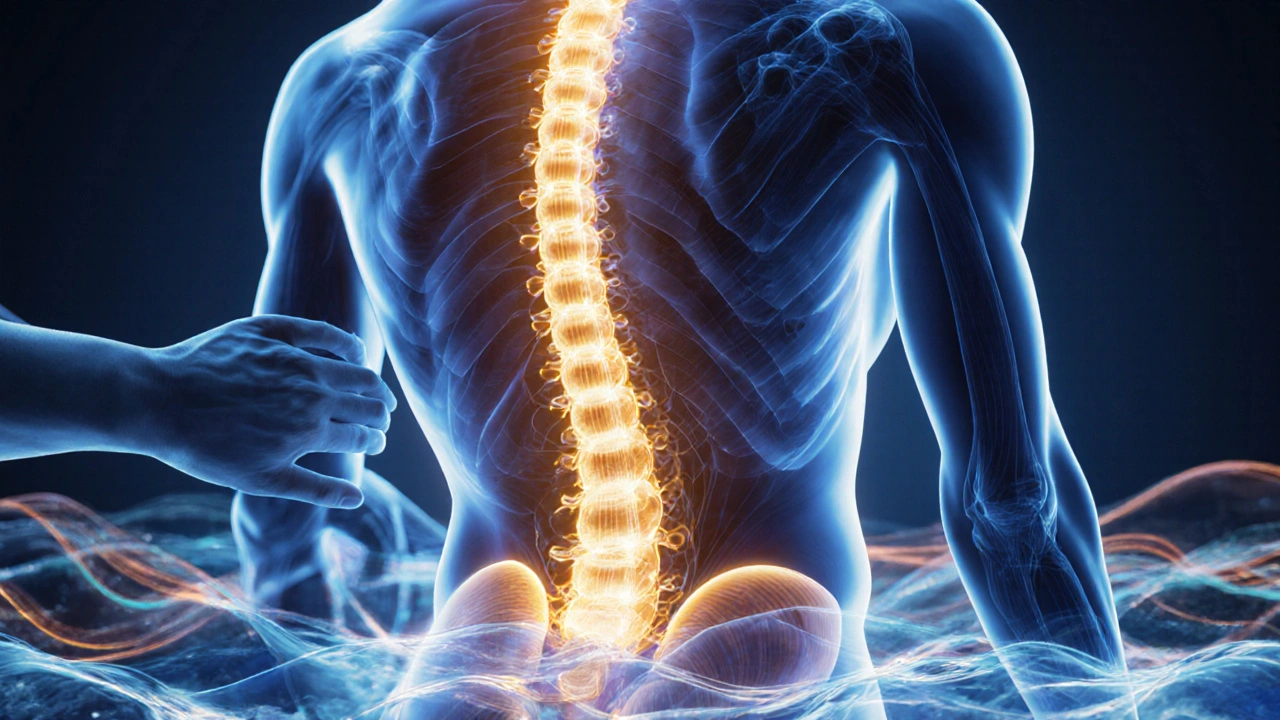Thai Massage Techniques for Pain Relief: Proven Methods to Ease Chronic Aches

If you’ve ever felt like your body is locked in a permanent state of tension-shoulders that won’t relax, lower back that aches after sitting for five minutes, or stiff hips that make walking uncomfortable-you’re not alone. Thousands of people turn to Thai massage not just for relaxation, but because it actually moves the needle on chronic pain. Unlike Swedish massage that glides over the surface, Thai massage works deeper. It’s not just rubbing. It’s stretching. It’s pressure. It’s movement. And when done right, it can reset how your muscles and joints feel.
How Thai Massage Actually Relieves Pain
Thai massage isn’t just a fancy name for a body rub. It’s a 2,500-year-old system rooted in Ayurvedic medicine and Buddhist spiritual practices. Practitioners use their hands, thumbs, elbows, knees, and feet to apply rhythmic pressure along energy lines called sen lines. These aren’t meridians like in acupuncture-they’re physical pathways where tension builds up, especially in the back, hips, and legs.
Studies from the Journal of Bodywork and Movement Therapies show that Thai massage reduces muscle stiffness by up to 35% after just one session. Why? Because it combines passive stretching with deep compression. Think of it like yoga, but someone else is guiding your body through each movement. Your muscles don’t have to work. They just relax.
People with lower back pain, sciatica, or tight hamstrings often report feeling relief within 24 hours. One 2023 trial with 87 participants who had chronic lower back pain found that those who received weekly Thai massage for six weeks reduced their pain scores by 52%, compared to only 18% in the control group. That’s not placebo. That’s biomechanics.
Key Techniques Used in Thai Massage for Pain Relief
There are five core techniques that make Thai massage uniquely effective for pain. You won’t find all of these in a standard massage spa.
- Compression - The therapist uses their palms, thumbs, or elbows to press firmly along the sen lines. This isn’t a light touch. It’s targeted pressure that breaks up adhesions in connective tissue. For someone with tight IT bands or shoulder knots, this can feel intense-but it’s meant to be.
- Passive Stretching - You lie still while the therapist moves your limbs into yoga-like positions. A common move is the seated forward bend where they gently pull your torso forward while keeping your legs straight. This stretches the entire posterior chain-hamstrings, glutes, lower back-all at once.
- Rocking - A rhythmic, gentle rocking motion applied to joints like the hips or shoulders. This helps reset proprioception, the body’s sense of where it is in space. People with chronic pain often have a misfired nervous system that thinks certain movements are dangerous. Rocking tells the brain, “This is safe.”
- Joint Mobilization - Gentle, controlled movements of the ankles, knees, wrists, and spine. Unlike chiropractic adjustments, this isn’t about popping. It’s about restoring smooth motion. For someone with stiff knees from arthritis, this can mean the difference between climbing stairs and avoiding them.
- Acupressure - Applying sustained pressure to specific points, like the space between the big toe and second toe (used for headaches) or the base of the skull (for neck tension). These aren’t random spots. They’re mapped to areas where pain radiates.
These techniques aren’t performed in isolation. A skilled therapist flows from one to the next, creating a sequence that feels like a dance. The goal isn’t to hurt you into relief. It’s to guide your body out of tension.
Where Thai Massage Works Best for Pain
Not all pain responds the same. Thai massage shines in specific areas:
- Lower back pain - Especially from sitting all day. The hip flexor and hamstring stretches directly target the root of most back strain.
- Neck and shoulder tension - Common in desk workers. The therapist will work along the trapezius muscles using thumb pressure and gentle neck rotations.
- Sciatica - Not a cure, but a powerful reducer of symptoms. By releasing the piriformis muscle in the buttock, pressure on the sciatic nerve drops.
- Tennis elbow - Compression along the forearm’s sen lines and stretching of the wrist extensors can reduce pain in under three sessions.
- Arthritis-related stiffness - Not for acute flare-ups, but for maintaining mobility. Gentle joint rocking helps keep synovial fluid moving.
It doesn’t work as well for acute injuries like sprains or fractures. If you’ve torn a muscle or have inflammation from an injury, wait until the swelling goes down. Thai massage is for chronic, overuse, and tension-based pain.

What to Expect During Your First Session
You won’t need to undress. Thai massage is done fully clothed, usually in loose, comfortable pants and a T-shirt. No oils. No table. You lie on a mat on the floor.
The session lasts 60 to 90 minutes. The therapist will start at your feet and work upward. You might be surprised by how much movement is involved. They’ll guide you into stretches you didn’t know you could do. Don’t resist. If it hurts too much, say so. Good therapists adjust pressure on the spot.
Afterward, you might feel a little sore-like after a good workout. That’s normal. But the next day? Many people say they feel taller, looser, like their body remembered how to move.
Who Should Avoid Thai Massage
It’s safe for most people, but not everyone.
- Don’t get Thai massage if you have a recent fracture, herniated disc, or severe osteoporosis.
- Avoid it during pregnancy unless you’re with a therapist trained in prenatal Thai massage.
- If you have blood clots, deep vein thrombosis, or are on blood thinners, talk to your doctor first.
- People with severe arthritis in the spine or recent spinal surgery should skip the spinal stretches.
If you’re unsure, ask your therapist about modifications. A good one will adapt the session to your body, not force you into poses.
How Often Should You Get Thai Massage for Pain Relief?
For chronic pain, consistency beats intensity. One session might give you temporary relief. Two to three a month can change how your body holds tension long-term.
Here’s a practical guide:
- Early stage pain - Once a week for 3-4 weeks, then reduce to every other week.
- Maintenance - Once a month to keep mobility and prevent flare-ups.
- High-stress or physically demanding job - Every 2-3 weeks.
Some people notice a drop in painkiller use after just two months of regular sessions. One client in Melbourne, a warehouse supervisor with 12 years of lower back pain, stopped taking ibuprofen entirely after six months of biweekly Thai massage.

Thai Massage vs. Other Types for Pain
How does it stack up?
| Technique | Pressure Level | Stretching Involved | Best For | Duration of Relief |
|---|---|---|---|---|
| Thai Massage | Medium to deep | Yes, full-body | Chronic tension, stiffness, mobility issues | 3-7 days, improves with consistency |
| Deep Tissue | Deep | Minimal | Localized knots, sports injuries | 1-3 days |
| Swedish Massage | Light to medium | No | Relaxation, mild stress | Hours to 1 day |
| Trigger Point Therapy | Very deep (focused) | Minimal | Referred pain, muscle spasms | 1-4 days |
| Physical Therapy | Varies | Yes, active | Post-injury rehab, structural imbalances | Long-term, with exercise |
Thai massage wins when you need both release and movement. Deep tissue breaks up knots. Thai massage rebuilds how your body moves around them.
What to Look for in a Thai Massage Therapist
Not everyone calling themselves a Thai massage therapist knows what they’re doing. Look for:
- Training from a recognized school in Thailand (like Wat Pho in Bangkok)
- At least 200 hours of formal training
- Experience working with clients who have chronic pain
- They ask about your pain history before starting
- They don’t force you into painful positions
Ask: “Have you worked with people who have lower back pain or sciatica?” If they hesitate or say “I do everyone,” keep looking.
Can Thai massage help with headaches?
Yes, especially tension headaches caused by tight neck and shoulder muscles. Thai massage targets the occipital ridge at the base of the skull and releases the trapezius muscles that often pull the head forward. Many clients report fewer headaches after regular sessions.
Is Thai massage painful?
It can be intense, but it shouldn’t hurt. There’s a difference between “good pain” (deep release) and “bad pain” (sharp, shooting, or burning). If you feel anything sharp, speak up. A good therapist will adjust pressure immediately. Most people say it feels like a deep stretch after a long workout-challenging but relieving.
Do I need to be flexible to get Thai massage?
No. Thai massage is adapted to your body, not the other way around. If you can’t touch your toes, that’s fine. The therapist will work within your range of motion. The goal is to gently increase mobility over time, not to force you into yoga poses.
How long does it take to feel results?
Some people feel looser after the first session. For lasting relief from chronic pain, most need 3-5 sessions over 4-6 weeks. It’s not a magic fix-it’s a reset. Like physical therapy, consistency builds results.
Can I do Thai massage at home?
You can stretch and self-massage, but you can’t replicate Thai massage alone. The techniques require leverage, pressure points, and joint movement that are hard to do on yourself. Think of it like trying to do your own chiropractic adjustment-it’s not the same. Regular sessions with a trained therapist are the most effective path.
Next Steps for Pain Relief
If you’re tired of popping painkillers or living with stiffness, Thai massage isn’t a luxury-it’s a tool. Start by finding a certified therapist with experience in pain management. Book a 60-minute session. Wear loose clothes. Don’t eat right before. And after? Drink water. Move gently. Let your body adjust.
Chronic pain doesn’t have to be your normal. Thai massage won’t fix everything, but it can give you back the movement you thought you’d lost.


